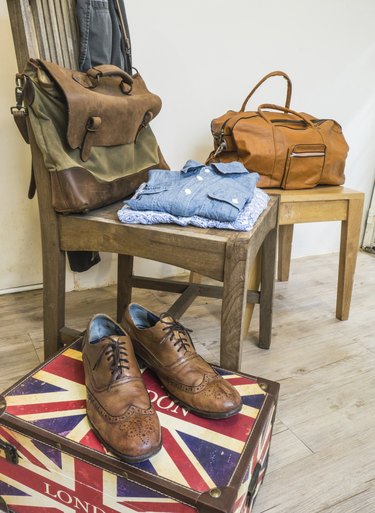
Chambray, a double-ply cotton fabric with a tight weave, is similar to denim but not the same. It has a white filler thread woven in with a colored background thread. But unlike denim's twill weave, chambray has a plain weave, so it's smoother and lighter in weight. Chambray is rugged but light, making it suitable for work wear as well as summer-weight shirts and skirts.
Chambray's Look and Feel
Video of the Day
Chambray most often comes in blue but can be found in other colors. The colored threads appear much more prominently, but if you look closely, you'll see the white thread woven in, giving the color a slightly faded look. Chambray is most often solid, but can also come in multicolored, patterned weaves. The fabric is very soft and smooth, and typically has a slight luster.
Video of the Day
Chambray's weave gives it a subtle checkered or crisscross pattern. Some sewing patterns require that the fabric be cut on the bias -- diagonally across the grain of the fabric -- to set the crisscross pattern on edge for a diamond-type look as well as give the garment more stretch and give.
How Chambray Is Used
Chambray has long been used for clothing, most often as a shirt fabric for button-down shirts with long sleeves and collars, such as oxfords. It's also used for light summer garments, including shorts, skirts, dresses, tops and even sneakers. Lycra and spandex can be woven into chambray to produce stretch fabrics for lightweight pants in various designs.
Other uses for chambray include quilting or bedding; sunhats for babies; and home decor items such as curtains, pillows, tablecloths, place mats and upholstery. Thanks to its ruggedness, chambray is also suitable for fabric covers for journals and scrapbooks; handbags and pocketbooks; napkins; and aprons.
Buying Chambray
Chambray is available in 42- to 60-inch-wide yardage that can be cut to your desired length and purchased at most fabric stores and some craft stores with fabric sections. Some online retailers may also offer chambray in precut form, including 5-inch charm squares, 2 1/2-inch strips and other common precuts.
History of Chambray
The word chambray comes from the town of Cambria in France, where the fabric originated. It was originally woven for farmer's work wear beginning in the late 16th century. More recently, chambray was the fabric of choice for blue work shirts, giving rise to the term "blue-collar worker." It is sometimes confused with Cambric, which has a similar but lighter weave, and originates from the same town.